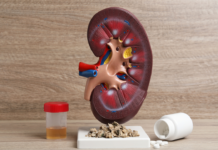Education Moment from Steve “The Kidney Nurse”
Sponsored by: Renadyl™
For individuals with end-stage renal disease (ESRD), hemodialysis is a life-saving treatment that helps remove waste and excess fluid from the body. One of the crucial steps in initiating hemodialysis is the creation of an arteriovenous fistula (AVF) or arteriovenous graft (AVG). This article’s goal is to provide an overview of the process involved in receiving an AVF/AVG for new hemodialysis patients.
1. Understanding the Importance of AVF/AVG:
The AVF and AVG are surgically created connections between an artery and a vein, typically in the arm. These connections are crucial for hemodialysis as they allow for efficient blood flow, enabling repeated needle insertions during dialysis sessions. Compared to hemodialysis catheters, AVFs and AVGs have a lower risk of infection and longer lifespan, making them the preferred choices for long-term hemodialysis.
2. Initial Evaluation and Assessment:
The process begins with a consultation and thorough evaluation by a vascular surgeon. The patient’s medical history, physical examination, and vascular mapping are assessed to determine the suitability of AVF/AVG creation. Vascular mapping involves using ultrasound to assess the size, location, and suitability of blood vessels for the procedure.
3. Education and Patient Preparation:
Once deemed suitable for AVF/AVG creation, the patient should undergo a comprehensive education program. This program should include information on the procedure, potential risks and benefits, care and maintenance of the access site, and the importance of maintaining good vascular health. Patients are encouraged to actively participate in their care and become knowledgeable about the process.
4. Surgical Procedure:
The surgical creation of an AVF or AVG is typically performed under local or general anesthesia. The surgeon makes an incision to expose the artery and vein, then connects them using a direct connection (AVF) or a synthetic tube (AVG). The choice between AVF and AVG depends on the patient’s vascular anatomy and overall health. The procedure usually takes a few hours, and patients can often return home the same day.
5. Post-Operative Care and Monitoring:
After the surgery, patients are closely monitored for any signs of complications, such as bleeding, infection, or clotting. The access site is regularly checked for proper blood flow and signs of infection. Patients are advised to avoid excessive use of the arm with the access site and to protect it from injury. Additionally, they are educated on proper hygiene, dressing changes, and when to seek medical attention.
6. Maturation and Use of AVF/AVG:
Following the surgical procedure, the AVF/AVG needs time to mature and develop a robust blood flow. This maturation process usually takes several weeks to months. During this period, patients may require temporary vascular access, such as a catheter, for hemodialysis. Once the AVF/AVG is deemed ready, it becomes the primary access for hemodialysis, allowing for efficient and safe dialysis treatments.
7. Ongoing Care and Maintenance:
Maintaining the health and function of the AVF/AVG is crucial for long-term success. Regular monitoring, including routine physical examinations, vascular access surveillance, and periodic ultrasound evaluations, is essential. Patients are educated on self-care techniques, such as proper cannulation, avoiding constriction of the access arm, and maintaining good vascular health through exercise and a healthy lifestyle.
The creation and maintenance of an AVF/AVG are vital steps in providing effective hemodialysis treatment for individuals with ESRD. The process involves a comprehensive evaluation, surgical procedure, post-operative care, and ongoing monitoring. By understanding the importance of AVF/AVG and actively participating in their care, new hemodialysis patients can ensure the longevity and optimal function of their access site, leading to improved outcomes and a better quality of life. If you have any questions concerning an AVF/AVG speak to your healthcare provider.
Learn more about our sponsor Renadyl here https://bit.ly/3sZDWbb
About the author
Steven Belcher, RN, MSN, MS, is a dedicated kidney advocate who began his journey 20 years ago as a dialysis nurse. This job inspired him to help as many people with kidney disease as he could. Not only did he spend two decades caring for a patient’s physical and emotional needs in a clinical setting, but he also educated the public on the risk factors of kidney disease. Some of his many philanthropic successes include being a keynote speaker at the National Association of Nephrology Technicians/ Technologists (NANT), presenting at community spaces, and launching radio shows.
He now focuses his time entirely on his organization Urban Kidney Alliance, which educates the public about kidney disease. His goal? To lower rates of Chronic Kidney Disease in urban communities in Baltimore, Maryland, across the country, and globally through education and collaboration.
Steve has also written the book “HOW TO SURVIVE OUTPATIENT HEMODIALYSIS: A GUIDE FOR PATIENTS WITH KIDNEY FAILURE.” You can read the book review here.
*These statements have not been evaluated by the US Food and Drug Administration. This information is not intended to diagnose, treat, cure, or prevent any disease. Always consult with a qualified healthcare professional prior to beginning any diet or exercise program or taking any dietary supplement. The content on our website is for informational and educational purposes only.




